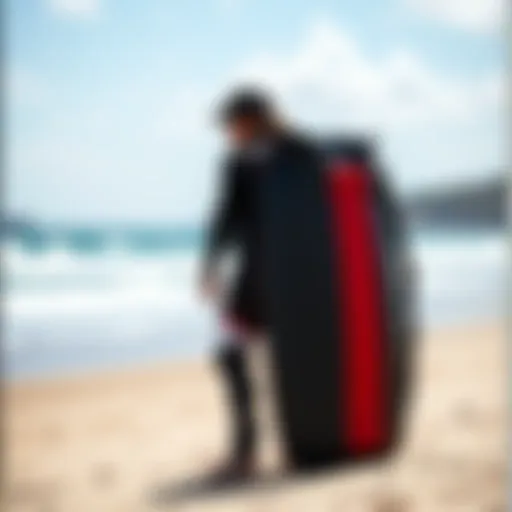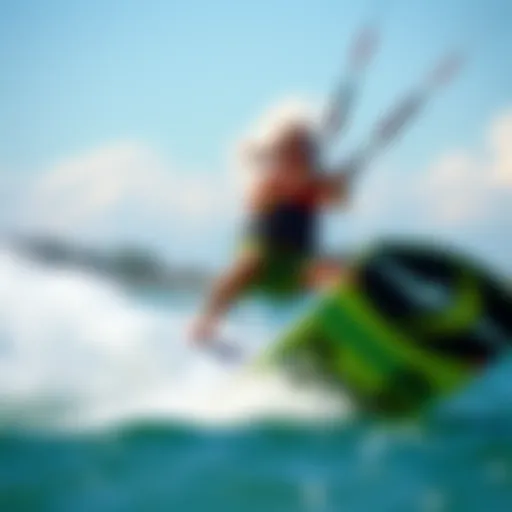Choosing the Perfect Sailing Drysuit: A Complete Guide


Intro
Choosing the right sailing drysuit is not just about style, it's about functionality and protection against the elements. In the world of kiteboarding, where conditions can turn on a dime, having the correct gear is crucial for safety and performance. The nuances of selecting a drysuit are often overlooked, but understanding materials, fit, and maintenance can make all the difference between an enjoyable day on the water and an uncomfortable ordeal.
Whether you're a seasoned sailor or just starting your kiteboarding journey, this guide aims to shed light on the essential elements of drysuits. It's designed to help you navigate through the myriad of options available, considering the unique demands of different sailing conditions and the varying types of gear that can be used.
Let's take a closer look at some key insights and strategies that will empower you to make an informed choice.
Understanding Drysuits in Sailing
Understanding drysuits plays a crucial role in the sailing experience, particularly for those venturing into varied weather and water conditions. As a sailor, ensuring your safety and comfort is paramount, and a drysuit is an excellent investment in this regard. The drysuit serves not only as a protective layer but also as an essential component of your overall gear, greatly impacting your performance on the water.
Functionality of Drysuits
The primary function of a drysuit is to keep the sailor dry and warm. Unlike wet suits, which allow water in yet trap a thin layer for insulation, drysuits create a complete barrier. This functionality is especially beneficial when sailing in cold or unpredictable environments, where exposure to water can lead to hypothermia. Drysuits typically feature seals at the neck, wrists, and ankles, which prevent water from seeping in.
Moreover, they allow for greater mobility compared to some older models. Many advanced drysuits come equipped with built-in insulation and can accommodate layering underneath, letting you adjust based on the climate. Here, ease of movement is as vital as insulation. As they say, you can't make a good impression when you're too frozen to move!
Types of Drysuits
Drysuits aren't just a one-size-fits-all situation. There are various types, each ultimately tailored for different needs and preferences. Let's break down three main types and explore their characteristics:
Full Drysuits
Full drysuits extend from neck to ankles, crafted to cover the entire body. This type is favored for its comprehensive protection as it effectively traps warmth and defends against chilly waters. One key characteristic is their layered construction, which provides adequate insulation while allowing room for additional thermal layers. Sailors appreciate full drysuits during long outings in cold environments, as they can withstand the fiercest seas.
However, there are downsides. The bulkiness may feel restricting for some sailors when compared to more streamlined options. Nevertheless, for serious adventurers facing extreme conditions, these suits are nothing short of indispensable.
Shorty Drysuits
Contrarily, shorty drysuits cover only the upper body and are ideal for warmer climates or those who produce more body heat while engaging in active sailing. One defining feature is their lighter weight, which offers greater flexibility and breathability, making them perfect for warm-weather sailing or for those who enjoy fast-paced activities.
They're easy to don and doff, often favored for trips where quick changes are required. Yet, the trade-off is a reduced level of warmth, which could pose a risk during unexpected cold fronts. Therefore, it’s essential to assess the intended use before committing to a shorty model.
Hybrid Models
Then there are hybrid models, which aim to combine the best features of both full and shorty drysuits. These versatile options often feature detachable legs or modular sections that can be adjusted according to preferences or weather changes. This flexibility makes hybrids a popular choice among adventurous sailors who may encounter varied conditions throughout their journey.
The unique selling point is adaptability, allowing for alterations on the fly as your sailing adventure unfolds. On the downside, the adjustments might not provide as clean of a seal as fully integrated suits, potentially letting in more water than desired in extreme circumstances. Nevertheless, for many trimmers looking for versatility, hybrids are a welcomed innovation in the world of sailing gear.
Key Features to Look For
When it comes to sailing drysuits, choosing the right features is just as important as the suit itself. These details can make or break your experience on the water. Features determine not just how well you stay dry, but also how comfortable and mobile you feel as you navigate waves and wind. With the right features, you can enjoy your time without constantly worrying about the gear you are wearing. Let’s break down what key features are essential, focusing on materials, sealing mechanisms, and their specific advantages.
Material Choices
Nylon vs. Neoprene
When comparing nylon and neoprene, each material brings something different to the table. Nylon tends to be lighter and dries quicker, making it easier to manage during those unpredictable weather changes. On the flip side, neoprene offers better insulation, keeping you warmer in colder waters. So, when you’re out there facing the elements, consider the trade-off between warmth and agility. While nylon is often favored in warmer climates due to its breathability, neoprene shines in cooler conditions, providing that extra layer of protection against the cold.
Gore-Tex Advantages
Gore-Tex holds a golden ticket in the realm of sailing drysuits. Known for being both water-resistant and breathable, Gore-Tex allows moisture from your body to escape while keeping water from coming in. This feature is invaluable when you are actively sailing and exerting yourself, as it prevents the dreaded clamminess that can come from sweating. Sailors often choose Gore-Tex for its durability; it can withstand some serious wear and tear while still performing at its best, making it a favorite among the pros.
Breathability and Waterproof Ratings
Breathability and waterproof ratings should be at the forefront of your drysuit search. A suit with high waterproof ratings will keep you dry, while breathability ensures you don’t overheat. Look for suits that balance both—these suits have been designed to allow air circulation without sacrificing waterproof integrity. Consider this: a suit that traps moisture can lead to discomfort and even hypothermia in extreme conditions. So, do your due diligence in shopping and read up on these ratings; it could be the difference between enjoying your day on the water and wishing you stayed on shore.
Sealing Mechanisms
Latex Seals
Latex seals can offer a snug fit that keeps water out, which is a huge plus for sailors. These seals create a barrier where your wrists and neck meet the suit, helping maintain warmth and dryness. However, some find that latex can be a bit too tight or cause irritation over long periods, especially if you wear the suit often. It’s a good idea to try before you buy; if they fit well, you won’t regret the increased level of protection.
Velcro Adjustments
Velcro adjustments provide versatility and ease of use. With these, you can customize your fit quickly and easily, which can be essential when conditions change suddenly. Plus, it allows for a little looseness if you start feeling too constrained during your adventure. However, make sure the Velcro is high quality—as they can wear down over time, affecting their effectiveness. Remember: a well-fitted suit keeps the chill out.
Zipper Types
Zippers might seem like a minor detail, but they are crucial in how easy or hard it is to get in and out of your drysuit. A heavy-duty zipper can resist water intrusion much better, while a diagonal zipper often makes it simpler to don the suit without help. Pay attention to the zipper’s placement: a poorly situated zipper can lead to discomfort and restrict movement. You want a robust zipper that ensures no water sneaks in, while also allowing you to zip up with ease.
"The right features in a drysuit can turn a bumpy sailing experience into one that's smooth and enjoyable."
Each of these aspects plays a vital role in the overall function of a drysuit, shaping your experience on the water. Taking the time to understand the materials, sealing mechanisms, and their pros and cons will yield great rewards when you find the perfect suit that fits all your sailing needs.
Finding the Perfect Fit
Choosing the right sailing drysuit is akin to getting the perfect pair of shoes—it must snugly fit to ensure optimum comfort and functionality. A drysuit that’s too big can leave gaps, allowing water in, while one that's too small can restrict movement and lead to all sorts of discomfort. Therefore, focusing on a suitable fit is not just about comfort; it significantly impacts your performance and safety on the water. Here, we’ll examine several crucial elements that contribute to finding that elusive perfect fit.


Sizing Considerations
Measurements to Take
Before diving headfirst into the world of drysuits, knowing your measurements is indispensable. The key characteristic of taking accurate measurements includes bust, waist, hips, inseam, and even foot size. Why is taking these specific measurements beneficial? Well, an ideal fit will allow for better insulation—keeping warmth in and cold water out, crucial for endurance.
A unique feature of measurements relates to fit preference—some sailors prefer a snug fit for enhanced heat retention, whereas others may prefer a looser style for ease of movement. Disadvantages might arise if the suit is gapped in critical areas like the neck or wrists, as this can compromise warmth. Hence, it’s wise to have these measurements handy while shopping.
Brand Variations
Drysuits vary significantly across brands, and understanding these differences is of utmost importance. The emphasis here lies on fit standards that each brand follows. While one brand may tailor suits for a leaner silhouette, another might cater to broader-body types. This characteristic is especially relevant for our article as it allows sailors to find the best fit according to their unique body shapes.
One notable feature of brand variations, for instance, is sizing charts published by brands. Some brands may offer extended size ranges, which ensures inclusivity for diverse body types. However, navigating through these charts can be tricky—as sizes may not be standardized, leading users to think they are one size when they are decidedly another. Therefore, when choosing a suit, consider trying multiple brands to discover the optimal fit.
Layering Needs
When thinking of fit, one must not overlook layering needs. Drysuits are designed to be worn over layers, which is particularly important during colder months. You want to ensure there’s enough room to accommodate thermal suits underneath without feeling crammed. The main benefit here is improved thermal protection—keeping you warm without sacrificing freedom of movement.
Unique features here often include room for adjustments. Some suits are designed with extra space in critical areas like the shoulders or hip joints to allow for comfort even with layers. But the downside is that this space can sometimes make the suit feel baggy if not combined with effective sealing. In summary, when considering layering, remember that the suit should remain snug yet accommodating.
Comfort and Mobility
Finding the right drysuit doesn’t stop at size—it’s about comfort during movement, too. If a suit restricts your movements, it can dramatically affect your performance on the water.
Articulated Joints
A distinct aspect of comfort in drysuits is articulated joints. These specially designed joints in the suit give you greater range of motion. Sailors often find this beneficial as it enables them to maneuver easily while managing sails or steering the boat. The design maximizes mobility while ensuring that the drysuit remains intact and leak-proof.
However, find a balance; too many articulations could put pressure points, making it less comfortable. It’s important to try suits that offer articulations before making that purchase to ensure it aligns with your sailing style.
Overall Construction
The overall construction of a drysuit also plays a pivotal role in comfort. High-quality materials and reinforced seams can go a long way in enhancing durability and comfort. When examining different drysuits, pay attention to how the suit is made—where are the seams, and what is the quality of the fabric?
An important feature to look at is the weight of the suit. A lighter material often suggests better comfort, but keep in mind that durability might take a hit. Thus, while weighing the options, it’s vital to ensure that the overall construction aligns with the demands of intense use.
Adjustable Features
Adjustable features provide personalized comfort levels, allowing you to fine-tune the fit according to your body. Look for adjustable cuffs, neck seals, and even waistlines—these can help to ensure that your drysuit stays snug, minimizing water entry while maximizing comfort.
A unique advantage is the versatility these features bring. You can adapt your suit for different conditions or layering needs. However, if adjustable features are not well-designed, they can create discomfort or restrict movement, thus it's crucial to assess the quality of these adjustable features before making a commitment.
Finding the right fit for a sailing drysuit is essential—not only does it enhance comfort and mobility, but it also ensures that you'll be prepared, no matter the conditions you encounter on the water. Understanding measurements, brand differences, layering needs, comfort aspects like articulated joints, overall construction, and adjustable features equips you with the knowledge to make an informed choice, helping you navigate the sailing water with confidence.
Performance in Different Conditions
When sailing, the conditions you face can vary widely, and so will the gear you need. Choosing the right drysuit can make a significant difference, not just in comfort but also in safety. Pay careful attention to how the drysuit performs under different weather conditions: cold water and warm water sailing require distinct considerations.
Cold Water Sailing
Cold water poses serious risks. Hypothermia can sneak up on the most seasoned sailor. That’s where a drysuit designed with cold water sailing in mind can be crucial.
Insulation Needs
Insulation in cold water is non-negotiable. A good drysuit should have inner linings that keep your body heat trapped, reflecting the warmth back to you. Think about materials like fleece or other synthetic blends that offer excellent thermal retention.
These insulative layers are an invaluable aspect, allowing heat retention without sacrificing mobility. A drysuit equipped for cold conditions often features thicker material, but this doesn’t mean you’ll be stiff as a board. Many brands design their suits to balance warmth with movement, so you can still maneuver your way around the boat with ease. It's a beneficial choice to invest in a suit that meets these insulation needs to ensure your time on the water remains safe and enjoyable. However, thicker insulation can come with added weight, which might not be ideal during all activities.
Layering Strategies
Layering under a drysuit is just as important as the suit itself. Wearing a moisture-wicking base layer is key. This includes materials that pull sweat away from your skin, allowing your body to breathe while staying dry.
A common strategy is using thermal tops when it’s frigid out, combined with insulation like fleece or synthetic materials. This ensures heat regulation; if you get too warm, you can peel a layer off without the need to entirely remove your drysuit. The flexibility of layering is a huge advantage for sailors, permitting adjustments based on changing conditions during the day. Still, some may find it cumbersome to have multiple layers on, which may limit their range of movement during intense sailing sessions.
Warm Water Sailing
In contrast to the icy depths, warm water conditions require their own set of considerations. While you want to maintain comfort, excessive heat can also be a problem.
Ventilation Options
Effective ventilation options are the name of the game when you’re sailing under a blazing sun. Look for drysuits that feature breathable panels or zippers under the arms. These design elements can promote airflow, which can be refreshing when the temps rise.
Good ventilation is balance; it’s crucial for regulating your body's temperature without compromising the waterproof nature of the drysuit. However, not every suit is built equally; some ventilation systems might not provide sufficient airflow, leading to damp interiors during long sails on hot days.
Managing Heat and Humidity
Managing heat and humidity is critical in warm water sailing. Staying cool means being aware of the suit’s material properties and how they react to moisture.
A good drysuit will ideally wick away sweat while keeping out the water. Look for suits made from lighter, highly breathable materials but still offer reliability in terms of waterproof capabilities. Keeping cool is not only about wearing the right gear; it’s also about hydration and avoiding sun exposure. The unique feature of these drysuits often lies in their balance of insulation and breathability, allowing for a more enjoyable experience in humid conditions. If neglected, however, overheating can lead to fatigue that significantly hampers performance.
Maintenance and Care


Taking care of your drysuit is just as essential as choosing the right one. Regular maintenance not only prolongs the life of the suit but also ensures it performs at its best when you're out on the water. A well-maintained drysuit is more than just a safety measure; it's a comfort enhancer that can make all the difference on those long sails.
Cleaning Techniques
Proper Washing Methods
When it comes to proper washing methods, the main aim is to keep your drysuit clean without causing any harm to its materials. The key characteristic of these methods is their gentle approach; using non-abrasive detergents designed specifically for high-performance fabrics. This is a popular choice in the sailing community, as it helps maintain the waterproofing qualities while getting rid of salt, sand, and any other residues that can accumulate after muddy adventures.
A unique feature of these proper washing methods is the avoidance of fabric softeners or bleach, which can damage the suit's integrity. Washing at lower temperatures can also preserve elasticity and moisture-wicking qualities. While it might be tempting to throw your suit in with your regular laundry, taking that extra time to wash it separately enhances its durability, ultimately making it an advantageous practice for any sailor.
Drying Procedures
Now, let’s talk about drying procedures. This step is crucial after a wash to ensure your drysuit remains in optimal condition. The right drying technique is to air dry, ideally in a shaded area, which prevents any potential fading or deterioration from direct sunlight. This method is beneficial as it reduces the risk of heat exposure which can warp the materials.
A unique aspect of appropriate drying procedures lies in the importance of ensuring the suit is turned inside out. This allows for thorough drying of the inner layers, preventing mold and unpleasant odors from setting in. Yet, using a heater or placing it in a dryer could compromise the structural integrity of the suit, making air drying the way to go.
Storage Recommendations
Optimal Conditions
For proper storage, optimal conditions are key. Keeping your drysuit in a cool, dry area where temperatures are stable is the best approach. The main benefit of this is it prevents degradation that might occur from moisture or extreme temperatures. This makes it a favored practice among seasoned sailors who know just how harsh the conditions can be in certain environments.
Another consideration is using a breathable garment bag instead of a plastic one, as this can help maintain airflow around the suit, limiting the likelihood of mildew. The real advantage here is reducing risk, allowing you to grab your suit, ready for that next adventure without worry.
Preventing Damage
When it comes to preventing damage, the key characteristic is taking precautionary steps. It’s all about being mindful of how you store, handle, and maintain your gear. This choice is essential because a few right moves can save you from having to replace expensive gear down the line.
One unique tip is to avoid folding the drysuit, as creases can weaken the material over time. Instead, hang it in a well-ventilated area to let it rest naturally. This approach not only keeps the suit intact but also allows you to inspect it regularly for any minor damages or wear. Ultimately, taking the time to follow these preventive measures will extend the lifespan of your drysuit and keep you safe whenever you hit the water.
Where to Buy Quality Drysuits
Selecting the right place to buy a sailing drysuit is just as crucial as picking the right suit itself. When it comes to investing in gear, the venue of purchase can have a profound impact on your overall experience. Each option comes with distinct advantages that can cater to different needs and preferences. Understanding these can enhance your shopping experience and, ultimately, your sailing adventures.
Online Retailers vs. Local Stores
Buying a drysuit can be done either online or at a local store. Both avenues come with their own set of pros and cons. Online retailers often provide a vast selection, usually at competitive prices. For instance, a quick scroll through websites like Amazon or REI can present options that you may not find in your neighborhood. It allows you to browse reviews at your leisure, and shop at the wee hours, fitting your busy schedule. However, one must keep in mind that without trying on the suit, you risk getting something that may be a size too small or too big.
On the other hand, local stores provide the undeniable advantage of trying before buying. You can physically feel the material and see how it fits. Specialty stores can offer personalized advice, something that online retailers often lack. However, local options may be limited in terms of selection and pricing. It’s a true give-and-take.
Brand Reputation and Reviews
User Feedback
User feedback plays a pivotal role when it comes to choosing a drysuit. From personal experiences shared in forums like Reddit to reviews on retail sites, here you can discover honest assessments about the usability and functionality of various brands. Typically, user feedback can range from very detailed accounts of performance in specific conditions to casual experiences that merely cover the basics.
One of the top characteristics of user feedback is its real-world perspective. Such insights provide clarity on how the gear performs in the heat of the moment. Encountering complaints about zippers failing or seals leaking can help you avoid potential pitfalls. However, these reviews can be subjective, influenced by personal preferences or unique experiences. Remember, a suit that worked marvelously for one person might be just a tad snug for another.
Expert Recommendations
Then, we have expert recommendations that take the conversation a step further. Industry experts typically provide data-backed opinions that can guide purchasing decisions effectively, especially if they focus on safety, gear longevity, and performance. They sift through countless reviews and product testing to narrow down options worth your dollar.
One key aspect of expert recommendations is their depth of knowledge; they often evaluate a product through a professional lens that average consumers might not consider. However, it’s crucial to note that expert opinions can sometimes lean toward higher-end products. While this can be beneficial for ensuring quality, it may somewhat remove accessibility for a casual sailor seeking a more affordable option.
In the end, combining insights from both user feedback and expert recommendations may guide you to the right drysuit that strikes that careful balance between quality, fit, and value.
Budget Considerations
When it comes to selecting the right sailing drysuit, budget considerations play an essential role in the decision-making process. Understanding how much you’re willing to spend not only impacts the specific options available to you but also affects the quality and functionality of the drysuit you ultimately choose. A well-planned budget can ensure that you strike a balance between affordability and quality, ultimately enhancing your sailing experience.
Price Range Overview
Staying informed about the price variations within the drysuit market allows sailors to make wise purchasing decisions. There are generally two categories of drysuits: affordable options and premium choices. Each comes with its perks, catering to various sailing preferences and budgets.
Affordable Options
Affordable drysuits are a popular choice, particularly among new sailors or those who sail infrequently. They typically offer basic waterproofing features, decent insulation, and comfortable fits at a lower price point. A key characteristic of these suits is their value proposition—providing essential protection without breaking the bank.
One noteworthy feature of affordable options is their simplicity. While they may lack some high-end materials or advanced sealing technologies, they serve the primary function of keeping the sailor dry and comfortable in moderate conditions.
Advantages of this category include:
- Cost-Effectiveness: Ideal for those getting started in sailing.
- Basic Functionality: Sufficient for occasional use without much frills.
However, some disadvantages arise:
- Limited Features: May not include advanced insulation or breathability options.
- Durability: They might not withstand rigorous use over an extended period.
Premium Choices


On the flip side, premium drysuits represent a worthwhile investment for serious sailors. Designed with advanced materials and technologies, they typically feature enhanced breathability, superior insulation, and better fitting designs. A distinguishing aspect of premium options is their longevity and performance in extreme weather conditions, providing unparalleled comfort on the water.
These suits often include unique features such as reinforced knee panels and intricate sealing systems, which contribute to their reputation for durability and reliability.
Advantages include:
- Superior Quality: High-end materials that withstand harsh conditions.
- Longevity: Designed to last with proper care, reducing the need for replacements.
Nevertheless, there are potential drawbacks:
- Higher Price Tag: The cost may deter casual sailors from making such an investment.
- Potential Overkill: May include features unnecessary for those who sail occasionally or in milder conditions.
Investment Value
Understanding the investment value of a drysuit goes beyond the initial purchase price. It encompasses considerations like long-term durability and safety features, which often justify the costs involved.
Long-term Durability
Long-term durability is crucial when evaluating drysuits. A suit that lasts multiple sailing seasons not only represents better value but also showcases high-quality construction and materials. With a suitable drysuit, you save money over time while ensuring safety and comfort on the water.
A distinguishing feature of durable drysuits is their robust stitching and reinforced seams. These elements resist wear and tear, especially when sailing over rugged waters or in challenging weather.
Advantages of long-term durability include:
- Cost Savings: Eliminating the need for frequent replacements.
- Reliable Performance: Being able to trust your gear in adverse conditions.
Potential disadvantages may be:
- Higher Initial Investment: Durable suits often come at a steeper price.
Safety Features
Investment in safety features is paramount for any sailor. High-quality drysuits come equipped with safety features like reflective strips, emergency whistles, and reinforced buoyancy aids. These elements enhance visibility and security during sailing, especially in emergencies.
The unique aspect of premium drysuits is their integration of these features with comfort and functionality. Sailors can have peace of mind, knowing their gear is tailored not only for performance but also for emergency situations.
Advantages of prioritizing safety features include:
- Increased Security: Being better prepared for potential accidents.
- Confidence on the Water: Knowing your gear supports your safety.
However, it’s important to consider:
- Balancing Cost and Features: Opting for too many safety features can inflate the price unnecessarily for some sailors.
All in all, understanding budget considerations, especially in relation to price range and investment value, is key when selecting a drysuit that caters to both your sailing habits and financial parameters.
User Insights and Testimonials
When it comes to selecting sailing drysuits, there's no shortage of information available. However, the voices of actual users provide a richer context that theoretical data often lacks. User insights and testimonials befriend the research process by painting a clearer picture of how drysuits perform in real-world sailing scenarios. They open a window into personal experiences, feelings, and preferences, which can be invaluable for prospective buyers.
Expert Sailors’ Views
Expert sailors, seasoned by time spent on various waters, understand the nuances of performance gear like no one else. Their testimonials often reveal critical insights that can sway your choice. For example, many professionals emphasize the importance of a snug fit. As one noted, "A drysuit that doesn’t fit right can undo all the advantages of its insulation and waterproofing. You need that second skin feel, especially while navigating strong winds."
For experts, materials are paramount. They argue for giving Neoprene a chance, thanks to its stretch and comfort. It’s not merely about staying dry; it’s about being able to pivot and react to conditions dynamically. Those who’ve tested various brands can often name the distinguishing features that set lightweight suits apart from more robust options.
"The right drysuit can be the difference between an enjoyable experience and an exhausting struggle. Don’t take shortcuts; invest in quality.” - A professional sailing instructor.
Moreover, experts highlight the role of climate action in selecting a drysuit. Sailors accustomed to colder zones stress on additional insulation layers. In contrast, those from milder climates may opt for breathability features. These experts offer guidance that resonates beyond the numbers found in product descriptions.
Beginner Experiences
On the opposite end of the spectrum are beginners, still learning to harness the winds. Their testimonials bring a fresh perspective, often pointing out features that seasoned sailors take for granted. A common theme among new sailors is the overwhelming array of options available and how it can become intimidating. One beginner mentioned, "I thought all drysuits were the same until I tried a few on. It’s like picking a pair of jeans; each one fits differently."
Curiously, many beginners report that they underestimated the significance of sealing mechanisms. A novice could easily feel disappointed, thinking they bought a good drysuit only to find it leaks around the neck or cuffs. They realize the hard way that every detail counts in ensuring comfort and safety.
Another takeaway from beginner testimonials is that comfort is paramount. Many strongly advise first-time buyers to consider mobility. One user shared, "I opted for a suit with articulated joints after struggling to move in my first cheaper drysuit. It was like trying to run in a straight jacket!"
In summary, the insights from both expert sailors and beginners create a holistic experience for understanding the essentials of choosing the right sailing drysuit. By listening to those who have actively navigated both successes and pitfalls, you're better equipped to make an informed choice. Customer feedback and testimonials shouldn't be an afterthought; they can guide you to a drysuit that'll become a trusted companion on your sailing adventures.
End and Recommendations
When it comes to selecting a sailing drysuit, having a solid grasp on the various aspects is crucial. The world of sailing is as unpredictable as the winds, and being adequately prepared can mean the difference between a thrilling adventure and a dismal experience. This article seeks to guide both novices and seasoned sailors through the often overwhelming choices available in the market today, helping you make informed decisions about your gear.
Final Thoughts on Drysuits
Drysuits are not just another piece of sailing gear; they are a lifeline, particularly in harsh conditions. Their purpose transcends comfort; they provide essential protection against elements that can be both shocking and dangerous. Suitable drysuited can make your experience more enjoyable by enabling you to focus on the thrill of sailing rather than being bothered by discomfort or, worse, hypothermia.
Whether you are exploring icy waters or navigating warmer climates, the right suit ensures you stay warm and dry. Remember, investing in a high-quality drysuit means investing in your own safety. No sailor wants to find themselves in a tight spot—literally faced with the cold water without proper gear.
Choosing the Right Suit for You
With every sailor having unique requirements, selecting the ideal drysuit demands a keen consideration of multiple factors. Begin with assessing your typical sailing environment. Do you sail primarily in colder waters, or do you prefer the sun-kissed surf of summer?
Once you’ve pin-pointed your environment, take into account your body type—since fit is non-negotiable. A well-fitting suit can empower movement while protecting against water. Ensure you choose a model with suitable sealing mechanisms, materials, and insulation preferences that suit your style.
Moreover, don’t forget about the importance of ventilated options for warm weather; you wouldn’t want to end up hotter than a jalapeño in a sauna.
- Test the Flexibility: Take your drysuit for a spin in the fitting area. Use the articulated joints and check if you can move freely.
- Seek Reviews: Don’t shy away from asking fellow sailors about their experiences. Different perspectives can illuminate aspects that may escape your notice.
In short, the perfect drysuit results from a balance of personal preference and external conditions. Do your homework, weigh your options, and invest wisely. Your adventures on the water deserve it.















